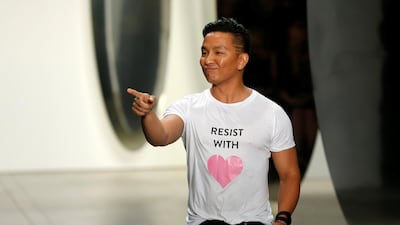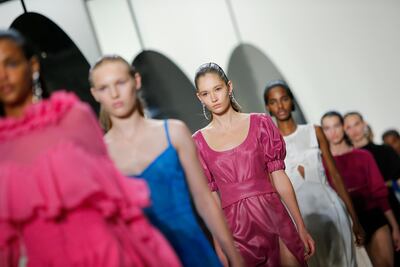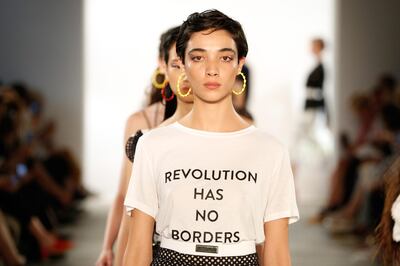"Grant me the strength to change the things I cannot accept." These were the words that opened Prabal Gurung's spring/summer 2018 show in New York in September. Clearly, this reworking of the first lines of Reinhold Niebuhr's famous Serenity Prayer (which reads: "Grant me the serenity to accept the things I cannot change"), was a barely-veiled swipe. But at whom? The White House? Politicians in general? The fashion elite?
This is not the first time that Gurung has pulled this kind of trick. His previous autumn/winter 2017/18 show featured T-shirts emblazoned with phrases like: "I am an immigrant" and "Girls just want to have fundamental rights". Gurung clearly has some things on his mind. "Everything the new government was talking about really challenged those of us who believed in equality, diversity and inclusivity," Gurung tells me over coffee in Abu Dhabi. Alarm at the change of leadership in America, his adoptive country, has galvanised something in this softly-spoken man.
As a brand, Prabal Gurung is known for creating stunning womenswear that is often to be seen on the red carpet. As the man behind the self-titled label, Gurung is known for being fair-minded, passionate about equality and, increasingly, unafraid to use the very public space of the runway to voice his views. "As a brand, what I stand for is the idea of feminism and femininity. I have always believed – and been a vocal advocate of, from the day I started – in visibility for women and ethnic minorities. The runway is the medium for expressing myself."
This isn’t just talk. Sitting in the front row of his spring/summer 2018 show in New York was Gloria Steinem, a highly respected feminist thinker, journalist and political activist. At the grand age of 83 – at Gurung’s insistence – Steinem was attending her first-ever fashion show. Three seasons before, Gurung had used Steinem’s quotes on his runway, and now here she was, sitting ringside. His excitement at her presence was palpable; he personally rushed out to greet her before the show began.
“Backstage, I sat with all my models and said to them: ‘We have among us Gloria, who some of you might know and some of you won’t’. Her coming to this show represents something; this is not a coincidence. You can walk down the runway as if it is business as usual, or you can walk the runway and remember the audience, and the platform you have, and the responsibility it comes with.”
Beyond the unusual front row and catchy slogans, crew members were decked out in T-shirts that read “Stronger in color”, and the runway was walked by models of every shape, size and race. Plus-size models paraded beside dark-skinned girls, alongside size 6 Caucasian, mixed-race and Asian women, with a few boys thrown in for good measure.
Selecting models that did not fit the traditional mould of tall, blonde and Caucasian was a clear act of rebellion. “I wanted it to be a collection that included diversity in the biggest possible way, with models of different sizes and races. Maybe I can change just one person’s thinking on what beauty is, especially in an industry where beauty is such a one-dimensional idea, because real women are different sizes.
“The greatest beauty a woman can have is when she embraces her femininity. To see a woman in her full feminine glory is so unnerving for so many people and, oftentimes, people don’t know how to handle it,” Gurung says.
The collection was also diverse. Although initially it felt optimistic, with loud pops of colour, it was filled with deconstructed dresses and pieces that were, quite literally, coming apart at the seams. Dresses and tops were made from sheer, see-though fabrics, perhaps raising questions about transparency in the wider sense, while practically every look had bits that were caught and held, or exposed and flaunted.
If it feels like Prabal Gurung comes at things from a slightly different perspective to the rest of the fashion pack, there is good reason. Gurung was born in Singapore and raised in the Nepalese capital of Kathmandu, and his path to fashion stardom has been anything but ordinary. "I am a boy from the mountains, and all I ever dreamed of was fashion," he says. "There were no Nepalese fashion designers for me to look up to. When I told people I wanted to be a fashion designer, I was told: 'That's a good hobby, but what do you really want to do?'
“I went to an all-boys British Catholic school, where I was just told I was different, that I didn’t belong, that I was not like regular boys. Even then, I thought, if they think I am different, then I will do things differently.” Some might have been crushed by such negativity; instead, it taught Gurung how to glean the positive from every situation, he says. He went on to study in Mumbai and moved to New York in 1999, to attend Parsons School of Design. During this time, he also interned for Donna Karan, before starting work for Bill Blass, as design director. He left to set up his eponymous label in 2009.
"As a fashion designer, my job is not to dictate what women must wear. The runway is one version of my idea, and good fashion is a conversation, an exchange of ideas, of thoughts. I wanted somehow to be able to create that dinner table, where I am able to talk about fashion, politics and art. It's not just hemlines – which I love, don't get me wrong – I wanted to create a luxury brand with a soul. I want to let people know that they matter."
Such lofty ideas now sit at the very heart of the label and the designer. But that has not always been the case. It was a chance conversation that led Gurung down his current path. “I was doing an interview and the journalist said to me: ‘It’s fashion, you aren’t exactly saving lives.’ And that really struck me. After she left, I called my family and said I wanted to start a foundation in Nepal. We started with 12 girls and now we have more than 350 children. We pay for their education until they graduate and help them to get their first job. After the earthquake in 2015, we started rebuilding work, and we have been able to help about 15,000 people.
“In Nepal, we believe in karma, and that what you do comes back to you. What you put out there, comes back to you tenfold. There is so much negativity on social media, so I wanted [my social media presence] to be like a Nepalese prayer flag. We have a flag with prayers written on it, and the whole philosophy is you hang it outside, and the wind blows the prayer all across the universe. I wanted my Instagram and my social media to be that.
“I have so much to be grateful for. Success is a true test of your character. Nothing else. It is testing you, what kind of person you are going to be, and who you really are. My whole thing is, whatever you do, do it with grace and love, and things always work out.”
At the end of every runway show, designers traditionally step out to take a bow. Some bob an unwilling head around the partition, while others revel in the moment, drinking in the applause. Gurung? At the close of his spring/summer show, he stepped out and started walking, his fingers held up in peace signs, wearing a T-shirt that read: “Resist with love”.
Vive la revolution.
________________
Read more:
How Andrea Incontri's background in architecture informs his work at Tod's
The best of Paris Haute Couture Week
Dubai's Ayesha Depala ventures into ready-to-wear
________________



